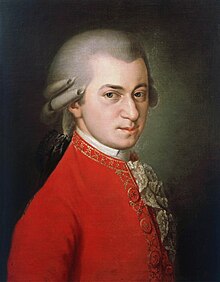
The Symphony No. 32 in G major, K. 318, was written by Wolfgang Amadeus Mozart in 1779, after his return from Paris.
Structure and analysis

The symphony, scored for strings, 2 flutes, 2 oboes, 2 bassoons, 4 horns, 2 trumpets, and timpani, is in the form of an Italian overture, consisting of three brief movements that follow one another without break:
- Allegro spiritoso
4 - Andante
8 - Tempo primo
4
The form is not a true italian overture or a da capo overture. The first movement unfolds as if in sonata form, with no expositional repeat. The two theme groups are stated amidst transitional material. Still in the first movement, a development begins that leads to the first theme of the exposition being worked in a number of keys. At the point where the music is in the dominant and seemingly ready to move the tonic for a recapitulation, the music segues to the slow movement. The slow movement is in rondo form (A–B–A–C–A–B). Again, right when the listener is expecting the rondo refrain to return, the music segues to the third movement, which continues the development of the first theme from the first movement before a "reverse recapitulation" is performed where the two themes of the first movement are recapitulated in opposite order.
The work was earlier considered as an overture to Mozart's operas Thamos, King of Egypt or Zaide, but this is unlikely because the dates of those works do not coincide with the autograph manuscript and also because the overture was generally the last piece to be composed for a stage work. In 1785 Mozart used the symphony as an overture for a Vienna performance of Francesco Bianchi's opera La villanella rapita.
The autograph score is today located in the New York Public Library for the Performing Arts.
References
- ^ Mozart, Wolfgang Amadeus (2005). Die Sinfonien IV. Translated by Robinson, J. Branford. Kassel: Bärenreiter-Verlag. p. XIV. ISMN M-006-20466-3
- Mozart, Wolfgang Amadeus (2005). Die Sinfonien III. Translated by Robinson, J. Branford. Kassel: Bärenreiter-Verlag. p. XIII. ISMN M-006-20466-3
- Brown, A. Peter, The Symphonic Repertoire (Volume 2). Indiana University Press (ISBN 025333487X), pp. 389–390 (2002).
External links
- Sinfonia: (dabey noch für 2 clarini) [autograph score in Mozart's hand in the New York Public Library]
- Symphony No. 32: Scores at the International Music Score Library Project
- Symphony in G K. 318: Score and critical report (in German) in the Neue Mozart-Ausgabe
- Pajot, Denis. "K318 Symphony #32 in G-major". Mozartforum.com. Archived from the original on 2013-01-29.
- Freed, Richard. "Program Note: Symphony No. 32 in G major, K. 318". Kennedy Centre.
| Wolfgang Amadeus Mozart | |||
|---|---|---|---|
| Biography | |||
| Music |
| ||
| Family |
| ||
| Influences | |||
| Related | |||
This article about a symphony is a stub. You can help Misplaced Pages by expanding it. |